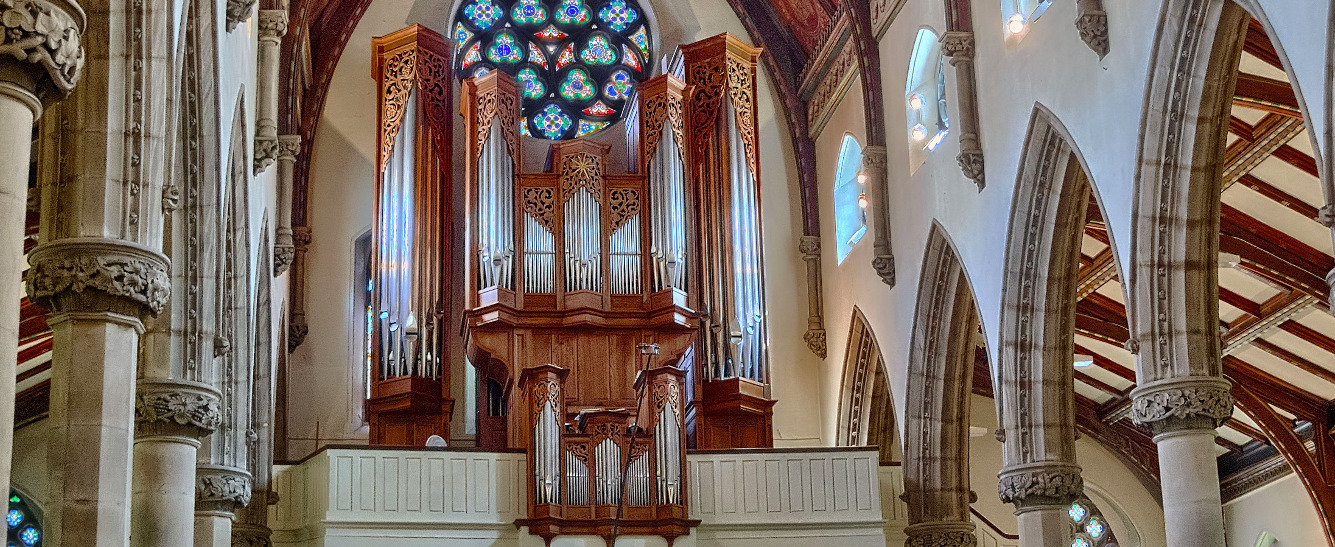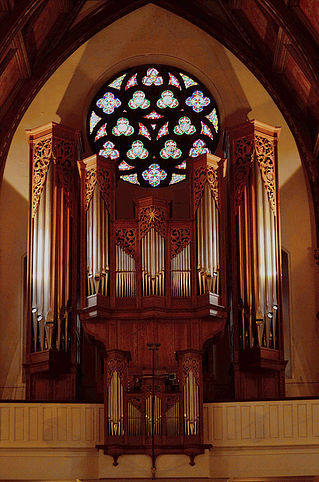


November 11, 2018
PATRICK WEDD
–––––––––––––––––––––––––––
Music in Canadian Cathedrals

November 11, 2018
PATRICK WEDD
–––––––––––––––––––––––––––
Music in Canadian Cathedrals

The 1980 Karl Wilhlem organ at Christ Church Cathedral in Montréal, Canada.
The 1980 Karl Wilhlem organ at Christ Church Cathedral in Montréal, Canada.
Introduction
Patrick Wedd, recently retired Director of Music at Christ Church Cathedral in Montréal, discusses church music in Canadian cathedrals with Vox Humana Associate Editor, Nicholas Capozzoli.
––––––––––––––––––––––––
Patrick, thank you for agreeing to this interview. Many organists are eager to hear about you and your wealth of experience as one of the leading church musicians in the Anglican Church of Canada. Like any denomination, musical trends come and go. How would you describe the current liturgical music scene in Canada, and what changes have you seen in the past 30 years?
I would say that, like all denominations, the variety of music used in liturgy has expanded greatly. But this is not something really new for us Anglicans — I was doing "soft rock" music in the Vancouver Cathedral in the 1970s and 80s before I came to Montréal. It's not a brand-new phenomenon, and Anglicans have always prided themselves on offering a wide variety of liturgical styles, so that within any diocese, there will be everything from very traditional parishes to low church congregational parishes where they just sing hymns in the Anglican style. I think the good thing is that traditional liturgical church music has gone on in our Canadian church all the time I have been involved in it, and while the number of places that have fully-blown serious music programs is perhaps fewer than it used to be, there are still places where the real tradition of Anglican music (and that from all periods) still goes on.
What does an Anglican cathedral music program look like in Canada (especially the French-speaking part) compared with the U.K.?
I think all of the Canadian Cathedrals that still carry a real music program are modelled after the British example, which isn't surprising, since we are an Anglican church. For example, we sing a full choral mass and evensong every Sunday; now we've added a French mass in the middle of the day, which is also fully choral with an entire Mass setting (normally in Latin). In those respects, we follow the British model, but I dare say that perhaps some of us in Canada sing a wider variety of repertoire than maybe even some English cathedrals do. We go right back to plainsong through new music written for us. But there is often somewhat of a tradition of staying with the Stanford, Parry, etc. tradition in England, and we try to make sure we do that, but include additional repertoire as well.
After living in Montréal for 32 years, are there any unique trends that set Quebec apart from other provinces? For instance, how does the Cathedral and its music program work within the bilingual nature of Montréal?
We have endeavored to include French in virtually all of our liturgies, so that there is at least one reading in French, and the prayers, for instance, alternate between English and French at our main Mass on Sunday morning. We also hold several Holy Day Masses on weekdays in French, which doesn't mean that the Mass Setting is necessarily in French (it's usually Latin), but the bulk of the spoken service will be in French. We have tried to take our position as a downtown parish seriously in this bilingual community, and we have tried to respond as much as we can to that nature of the city, where, after all, most people live in both languages a lot of the time. You'll find that most residents of Montréal are bilingual.
In the heart of downtown Montréal, Christ Church Cathedral is a very busy place, especially on Sundays. Could you take us through your typical Sunday?
Sundays are very busy! I arrive around 8:00, and I get music out and ready for our 9:00 choir rehearsal. We often sing in different parts of the building, so it often involves setting up chairs, moving the portative organ around if we need it, etc. The choir comes at 9:00, and then we rehearse the music for the 10:00 Mass. That Mass goes until around 11:30 or 11:40, depending on how long the music lasts, and then I normally get something like a half hour turnaround when I then go into a 30-minute rehearsal with the quartet that sings for the 12:45 Mass, our French Mass. That usually finishes at 2:00. I then have to get ready for Evensong at 4:00 — the choir normally comes at 2:30 or 2:45 to prepare. By the way, that service is broadcast live on a local radio station called Radio Ville Marie. Normally, that service is finished around 5:00, then there's a bit of cleanup, and I'm done by 6:00. It's a long and pretty active day.
The Cathedral’s organ was built by Karl Wilhelm, and although its specification veers toward the neo-Baroque persuasion, you program all kinds of Anglican music from William Byrd to Jonathan Dove. What are the strengths and weaknesses of this organ as an instrument being primarily used in the aesthetics of the English Victorian-style liturgy?

Karl's instruments tend to be kind of North German in their inspiration, and our instrument has a fully-fledged Great and Positive in that tradition. The fortunate thing for us is that Gerald Wheeler, who was director of music when the organ was installed, convinced Karl that he needed to build to what amounts to a pretty complete swell organ. It has just nine stops, but it allows us (with a bit of invention) to accompany a wide variety of repertoire, including the English Romantic literature. We can, in fact, play Stanford, and certainly Howells, Leighton, etc.

We have always struggled with the fact that the organ tends to be a bit top-heavy, sonically. The acoustic of the room is not very generous, especially at the 16' level; the pedal reeds don't have any trouble making their way into the room, but the flues are problematic. However, the instrument has proved itself remarkably flexible, and the foundations of the organ are remarkably warm and ingratiating; the flutes are quite pretty and the principals quite round, and if you just bulk up the 8's, it all sounds rather pleasant downstairs.
Speaking of organ music, you have played the complete works of Messiaen, Alain, de Grigny, Buxtehude, Ligeti, and Leighton, but you have a special affinity for Canadian repertoire. Your Naxos Recording of Healey Willan’s organ music (available here) has garnered critical acclaim. How did this recording project come about?
Willan's music has always interested me greatly. Many people know the Introduction and Passacaglia and Fugue, which is a world class piece, but many of his other works had not been recorded so much, and never had the exposure I felt they deserved. Daniel Courville, a sound engineer, recorded a demo at St. Jean -Baptiste in Montréal. We sent it off to Naxos, and it was one of those projects that no one else had thought of, and so they were pleased to make it happen. It still remains, I think, the only CD devoted to his music exclusively, and that contains his major preludes and fugues, and passacaglias and fugues, as well as the excellent plainsong preludes (which I think are his very best chorale preludes).
What advice do you have for young organists and conductors who wish to pursue church music as a career? What qualities do you look for when interviewing young organists?
Perhaps it's too basic to say, but the obvious thing is an interest in the church and its music. But there are a number of young organists who only want to be recitalists and to teach — of course, there's nothing wrong with that, but for me, that interest in the church and its liturgy is very important (I was fascinated by that right from the beginning). And then after that, I think a real interest in choral music and how to help people sing in choirs effectively, which is often, I found, as much a question of interpersonal skills as understanding of technique. It's important to enable people to do their best, and work as a team. I think, ideally, an interest in a very wide variety of musical periods and styles is also important. The church has high quality music from thousands of years, and ideally, one would like to include that in the liturgy. That means that one has to be actively interested in various periods and styles, so that we can reflect the performance practice of particular periods, so that not everything sounds the same. That way, you can allow the singers to make a warmer, rounder sound for Romantic music, and a cleaner sound for early music.
On June 24, 2018, you celebrated the end of your final choral season at the Cathedral. What are some of your proudest achievements as Director of Music? Are there any hopes or fears for the future of music at the Cathedral?
We've had some very good opportunities to do some major pieces like the Langlais Messe Solennelle (which we've done at Easter with brass), the Vierne Messe, and major Renaissance works. We've also had the chance to do several Haydn and Mozart Masses with string ensembles. More than once, we have presented the Stravinsky Mass with 10 wind players, on top of the week-to-week run of things with organ. But the services with additional instrumental support have been some of my best recollections. We have had several pieces of music written for us, and had the chance to premiere them. One is a very excellent unaccompanied Mass by John Burge, a Canadian composer on the faculty at Queens University in Kingston, Ontario; for the Messiaen anniversary year, 2008, he wrote a Mass based loosely on the harmonic structure of Le banquet céleste, so it's called Missa Brevis Banquet céleste, and we had a chance to both premiere and record it. More recently, a tenor in the choir, Jason Noble, a doctoral candidate at McGill University, has written several pieces for us, most recently a fine Mass for Easter Day for choir, brass, handbells, organ, and soloists. And then we've had opportunity to do services in collaboration with other organizations, most recently for example, for the convocation of the National Convention of the Royal Canadian College of Organists.
My hope is that what we've established as a really serious music program, encompassing literature from all periods, will continue to be a beacon in this country for the tradition of art music in church. In general, and not just in North America, quality church music is perhaps not done as much as it has been. Even in this diocese, music programs have failed for various reasons, and that's a very unhappy occurrence. Any fears might be around the whole area of support for real music in the liturgy as the church makes its way through the twenty-first century. Honestly, I don't see that as a problem in this Cathedral, because there's a general and deep-seated support among the congregation and our church officials (in addition to its outreach, social justice action, inclusivity, etc.). I hope that enough places are going to continue to do real music across this country as it belongs — in the liturgy.
––––––––––––––––––––––––
From the Editors
Patrick Wedd is also a prolific composer of anthems, psalms, canticles, Masses, Passions, and hymn arrangements. In celebration of his retirement, he has graciously allowed Vox Humana readers to reproduce and perform one of his compositions, two hymn arrangements with descants, and an Anglican chant psalm:
––––––––––––––––––––––––
Canadian-born
The views and opinions expressed in this article are those of the author, and do not necessarily reflect the position of Vox Humana.